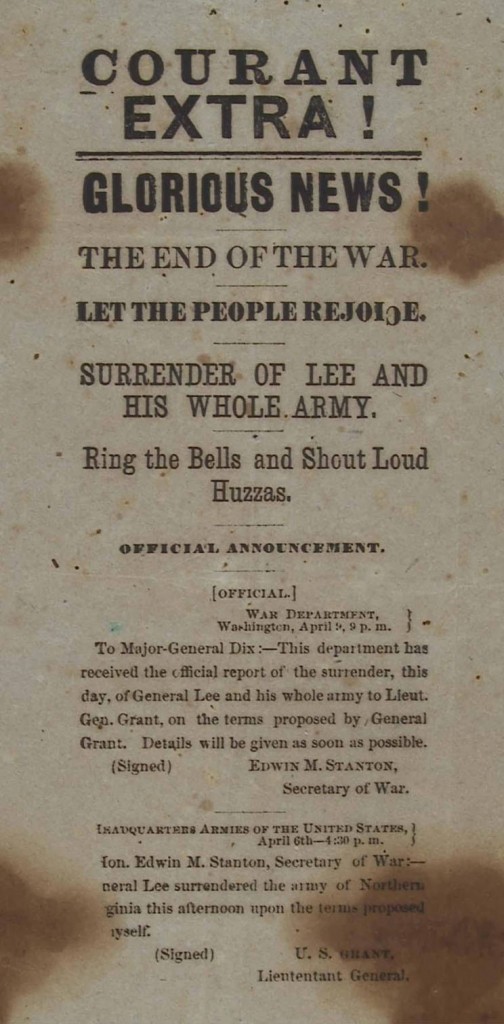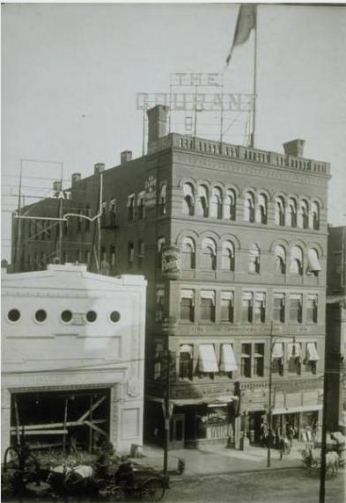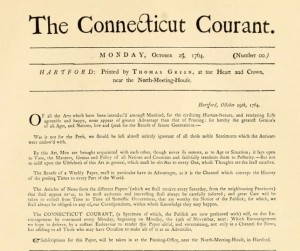The Hartford Courant is a source for news and history unlike any other. The paper not only kept readers around the country informed on important local, national, and international events for over two and half centuries, but access to its well-preserved archival resources provides important insight into life in the United States dating back to its very conception. Founded prior to American independence, The Hartford Courant is the country’s oldest newspaper in continuous publication.
On October 29, 1764, New Haven printer Thomas Green began publishing The Hartford Courant (then known as The Connecticut Courant) out of the Heart and Crown Tavern in Hartford, Connecticut. His first issue consisted of just 4 pages printed on 8 ½ x 14 ½ paper, but Green saw it as the first step toward his goal of informing the world about the important events of his time.
Green came from a family of printers and his new weekly paper became just the third newspaper available in the Connecticut colony. Green sold advertising space in the Courant in return for cash or produce and supplemented the paper’s revenues by selling clothing, hardware, and spices out in front of his office.
While Green reliably published a new edition every Monday, the actual size of the paper varied from week to week based on the supply of paper available. Paper shortages were a common occurrence throughout the colonial era and Green often asked his readers to save their linen and cotton rags for use in paper production.
A Revolutionary Paper
Green eventually sold The Connecticut Courant to his assistant Ebenezer Watson, and Watson promptly addressed the paper shortage problem by building his own paper mill nearby. When Watson died from smallpox in 1777, his widow, Hannah Bunce Watson, took control of the paper—becoming one of the first female publishers in America.
The Connecticut Courant played a very important role in keeping readers abreast of events transpiring during the colonial period. The paper provided detailed coverage of colonial reaction to The Stamp Act, the Boston Tea Party, and on July 15, 1776, the paper published a copy of the Declaration of Independence in its entirety. The Courant soon became the most widely circulated newspaper in the colonies and so important to coverage of the Revolutionary War that when the local paper mill burned to the ground, the Connecticut legislature authorized a lottery to pay for its reconstruction.

Handbill issued by The Hartford Courant in April 1865 that signaled the end of the Civil War – Connecticut Historical Society
In the years that followed the war, the paper maintained its prominent position in American culture. It ran ads for such famous Americans as George Washington, became the subject of an unsuccessful libel lawsuit filed by Thomas Jefferson, and in 1807, announced the arrival of a new era of transportation by publishing Robert Fulton’s account of his steamboat voyage from Albany to New York City.
While the Courant continued to offer a weekly edition of its paper right up until 1896, on September 12, 1837, it supplemented its news coverage with a new daily edition—the first daily newspaper in Hartford. During this time, the paper not only covered important events and ran advertisements for suppliers of goods and services but reflected the strong pro-slavery sentiments that existed in Connecticut by running ads meant to aid in the capture of fugitive slaves. Though slavery maintained deep roots in Connecticut, the paper stopped running these advertisements by the time state legislators abolished slavery in 1848. Shortly after, the Courant became a vocal supporter of Abraham Lincoln and the new Republican Party.
Newspaper Adjusts to An Age of Digital Media
In 1913, with its daily edition in high demand, the paper published its first-ever Sunday edition. Throughout the decades that followed, Connecticut residents repeatedly turned to The Hartford Courant for coverage of the military conflicts erupting across the globe, the rapid commercial and political transformations occurring at home, and the country’s foray into outer space.
The steady growth of the paper in the 20th century eventually caught the eye of a Los Angeles-based media company called Times Mirror, and in 1979, amid a flurry of media-outlet mergers, Times Mirror purchased the paper. The years that followed witnessed the paper’s staff grow to a high of just under 400 employees in 1994 and saw the newspaper win two Pulitzer Prizes—one in 1992 for a series of stories on the troubles plaguing the Hubble telescope, and the other in 1999 for the paper’s coverage of the 1998 shooting at Connecticut lottery headquarters.
In 2000, the Chicago-based Tribune Company purchased Times Mirror. With a background in television, radio, and publishing, Tribune helped The Hartford Courant maintain its credibility among the frenzy of new media outlets that emerged in the digital age. Other changes brought by the industry-wide shake-up of traditional print journalism, such as shrinking circulations and declining revenues from advertising, also led to significant reductions in Courant staff—particularly when its parent company underwent restructuring during a roughly 4-year period of Chapter 11 bankruptcy protection.
Today, as it continues to navigate the changing media landscape, The Hartford Courant maintains a daily circulation of over 200,000 (and almost 300,000 on Sundays). Its recently digitized archives offers researchers and historians a firsthand look at the evolving American landscape over the past 250 years.










